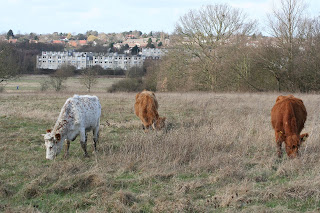Now, I had wondered about doing a big post about that chap in Scotland who shot a bird of prey belonging to a falconer, and the wider problem of illegal shooting of raptors by those so absorbed in their own self interest that they, well, shoot birds of prey. But my politically semi-literate, ill-informed rants on such, and indeed wildly different subjects are familiar to anyone who knows me on FB, and I even I am beginning to find them unnattractive and a little bit boring. This doesn't mean I'm not going to rant, I will merely ensure that my ranting is not ill-informed. To get here is to do some research, which takes time, and that means I'm not going to rant right now. When I do, I shall make informed proposals about what should be done.
Instead, I'm going to talk about my day in Roding Valley, and indulge my national talent for being surprised by the weather.
I arrived at nine in the office for a training day with some of the volunteers. We were looking to start surveying the site for breeding birds, and some other taxa too. After a breif lecture we set off onto the reserve. The sky was blue, and despite the persistent feeling it'd been an early morning, it felt good to walk underneath it, enjoying the sensation of the sun warming my dark clothes. I was clearly a creature which had become, over the winter, desperate for it. As we crossed the little bridge over the M11 and reached the reserve itself on the other side, I noticed a couple of large raptors circling above us, riding on a thermal. They were Common Buzzards, Buteo buteo, one considerably paler than the other, apparantly unperturbed by the humans staring up at them. Perhaps they were hunting (Buzzards prey on anything big enough to see and smaller than a Buzzard) but it didn't seem like a leap of the imagination to suggest they were just enjoying the sun like me. They climbed away and out of sight.
As the day wore on and warmed up, and we had seen several of the bright green Rose Ringed Parakeets (Psittacula krameri) flying over us with their squawking alarm calls, we made our way down to the banks of the River Roding itself, a small, fast flowing river which meanders along the valley floor. A couple of Teal (Anas creccia) , winter stragglers, swam on it, while a Little Egret (Egretta garzetta) took off in alarm, with bright yellow feet trailing. As we walked down the river I think we must have flushed the poor bird about a dozen times. We passed a Blackthorn in full blossom with honey bees and bumble bees buzzing about the rose white blooms. A Red Admiral butterfly alighted breifly on the opposite bank. It truly felt like spring and the wildlife echoed this. Robins (Erithacus rubecula) and Great Tits (Parus major), the latter with their repetitive bi-syllabic song, could be heard all over the place. The Warden remarked to me that the colour from the blackthorn was a taste of things to come. Roding is locally noted for its good butterfly populations and the spectacular displays of wildflowers of its hay meadows and pasture. I've only been involved since January and I have yet to see it in it's full glory. A Mute Swan (Cygnus olor) and a couple of nervous Mallards (Anas platyrynchos) completed the bird list for the riverside.
Several gulls dotted the recreation ground on the other side of the Roding, enjoying the short grass which seems to suit them so well. Some of the Black Headed Gulls (Chroicocephalus ridibundus) were in full winter plumage, but most had at least something of the brown hood returning. Common (Larus canus) and Herring Gulls (L. argentatus) completed the flock, later inspection demonstrated.
As we walked back up to the complex with the staff offices in it to have our lunch, we saw a small, greenish bird with a distinct supercillium take off out of the grass. I was unable to call it but someone decided it had to be a Chiffchaff (Phylloscopus collybita) rather than any of the other "leaf warblers." Although once considered a summer visitor, some chiffchaffs increasingly winter here in the UK, although not in any great numbers, so I hopefully imagine this chiff to be my first summer migrant of the year. The blue wing flashes on a pair of jays we spotted as we walked up the green lane looked very striking in the sunshine.
Roding Valley lies between the town of Chigwell (think old BBC sitcom Birds of a Feather) and the Epping Forest Ridge, sort of Western/Metropolitan Essex. The housing estates of Debden and Loughton overlook one side of the reserve. It doesn't feel like the kind of place likely to house a small herd of dairy cows (Bos taurus) but such arrived on the reserve yesterday, to act as conservation grazers, managing the sward more sensitively than someone with a lawnmower could. The obligatory fence checks and gate checks followed as some of my colleagues were instructed in how to check on the cattle. After we had been introduced to the old girls, and those who needed to know knew how to feed them and to recognise the warning signs if they became ill, I made my way back through the gull flock, under a passing Cormorant (Phalacrocorax carbo) and by another Red Adminral, towards the station and home.
Spending some time under a bright blue sky served to underline how much I have been craving the sun through the winter, really craving it. I'm a creature of a temperate summer if I am anything!




No comments:
Post a Comment